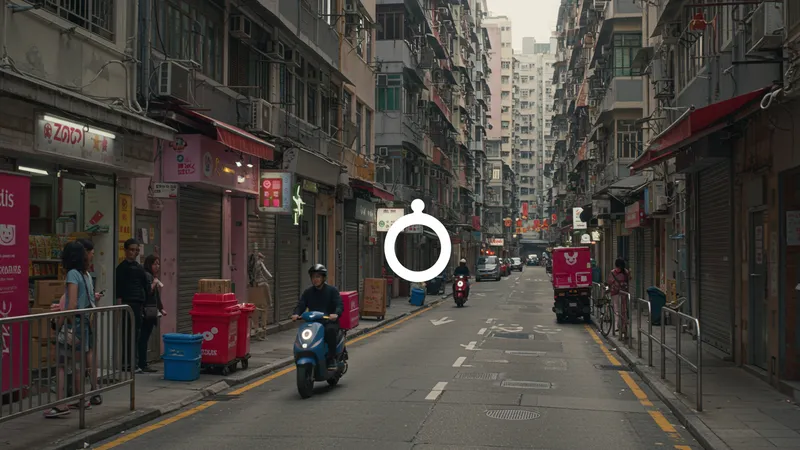

Imagine placing an online order and receiving your items at your doorstep in less than an hour. This is the essence of quick commerce, a model that’s reshaping how Hong Kong residents experience everyday shopping. Unlike standard e-commerce, which typically promises delivery in a day or two, quick commerce platforms use advanced logistics and strategically located micro-warehouses to bring groceries, meals, and daily essentials to urban consumers in record time.
Quick commerce in Hong Kong is more than a trend—it's becoming an integral part of city life. As dense urban environments and busy lifestyles demand ever-faster service, digital platforms are racing to redefine convenience, combining real-time inventory, local fulfillment, and app-based ordering. This rapid evolution is creating both new expectations and new challenges across the retail landscape.

Hong Kong's quick commerce market is expanding rapidly, setting new standards for consumer expectations. Platforms like foodpanda and Zippy have established a strong local presence by integrating with logistics providers and local retail outlets. Their real-time tracking and flexible payment systems create a seamless experience that appeals to tech-savvy users and busy professionals alike.
The surge in demand for fast delivery has triggered advancements in micro-fulfillment centers, allowing companies to keep products close to high-density neighborhoods. Such hyperlocal storage guarantees that urgent needs—from a forgotten ingredient to last-minute gifts—can be met within minutes, marking a shift from traditional shopping to truly on-demand experiences.
Hong Kong's urban density and sophisticated digital infrastructure provide an ideal environment for quick commerce to thrive. With more residents working late hours and juggling packed schedules, there’s increasing reliance on platforms capable of delivering reliable, rapid service for everything from dinner ingredients to daily necessities. This evolution is influencing not just how people buy, but what they expect from retailers and restaurants.
While quick commerce introduces convenience, it also raises important operational questions on sustainability, last-mile efficiency, and labor dynamics. As more businesses optimize for ultrafast service, experts predict a further transformation in supply chains and retail strategies—potentially influencing pricing and product assortment to keep up with the race for speed.
As we continue, deeper insights emerge—revealing how this wave of innovation is impacting business models, consumer behavior, and the everyday rhythms of life in Hong Kong. The deeper details reveal even more valuable insights ahead…
The explosive growth of quick commerce in Hong Kong is fueled by the city’s compact geography and high population density. The ability to cover more customers with fewer distribution points significantly increases the model’s efficiency compared to sprawling regions. Successful platforms analyze order patterns and position their inventory strategically, ensuring rapid delivery even during busy urban hours.

Consumer habits in Hong Kong have shifted dramatically, with people preferring the certainty and speed provided by established platforms like foodpanda, Zippy, and GOGOX. The habit of ordering groceries, hot meals, or convenience goods via smartphone has become ingrained, reflecting both a demand for immediate fulfillment and broader lifestyle changes in response to fast-paced urban routines.
Technology is at the heart of quick commerce’s advancement. Sophisticated mobile apps enable live order tracking, real-time communication with couriers, and seamless payments. Behind the scenes, logistics integrations route orders to the nearest micro-warehouse and assign the fastest available delivery agent, constantly shaving minutes off the end-to-end delivery time.
Businesses leveraging quick commerce in Hong Kong are encountering new operational challenges, particularly regarding sustainability and labor. The pressure for instant delivery necessitates robust workforce management and careful planning to avoid burnout and inefficiencies. As demand grows, the sector must continue balancing customer expectations with viable business practices.
Retailers operating quick commerce services in Hong Kong frequently adopt a hyperlocal approach. They position mini-warehouses within densely populated districts, storing high-demand products in close proximity to key customer clusters. This enables platforms to fulfill orders rapidly, often using electric scooters or bicycles for short urban trips, which helps optimize cost and delivery speed.

Another strategic focus is on order bundling and time-slot optimization. Companies analyze purchasing trends to pre-pack popular products, anticipating peak times such as lunchtime or after work, further reducing preparation and dispatch times. Collaboration with local shops and restaurants also helps platforms like Zippy and foodpanda expand their product offerings and maintain a local flavor.
Efficient route planning is essential for reducing costs associated with last-mile delivery. Real-time analytics and AI-powered dispatch systems allow businesses like GOGOX to match couriers and packages efficiently, minimizing detours and idle time. With insights from urban traffic data, they adapt dynamically to avoid congested areas and meet promised delivery windows.
Quick commerce players are increasingly investing in green logistics, turning to electric vehicles and reusable packaging to address sustainability concerns. These measures not only reduce operational costs in the long run but also enhance brand reputation among environmentally conscious customers in Hong Kong.
Hong Kong consumers have come to expect transparency and speed from quick commerce platforms. The continuity between placing an order and receiving real-time updates has raised the bar for retail experience, pushing businesses to prioritize user-friendly interfaces and hassle-free payment systems. Consumer trust is built on consistent delivery times and accurate order fulfillment.

Competition among platforms like foodpanda and Zippy has accelerated innovation. They routinely introduce membership programs offering discounted delivery fees, loyalty points, and exclusive products to attract and retain users. Real-time chat support and hassle-free refund policies further differentiate market leaders and align with rising consumer expectations.
Delivery timing and accuracy are crucial differentiators. Platforms compete on fulfilling even last-minute orders—whether it’s groceries for dinner or a missing ingredient for a recipe. The ability to offer rapid service without sacrificing choice has made quick commerce particularly popular among young professionals and families managing busy schedules in Hong Kong.
This intense market competition has resulted in an ever-expanding product selection, with platforms partnering directly with local businesses and global retailers. As a result, Hong Kong residents enjoy an extraordinarily wide range of quality goods at their fingertips—delivered faster than ever before.
Despite its rapid growth, quick commerce in Hong Kong faces ongoing challenges. Traffic congestion, rising delivery costs, and managing a large, flexible workforce can impact service reliability and profitability. Companies must continuously adjust their business models to keep pace with fluctuating demand and urban logistical complexities.

Maintaining a balance between service speed, operational sustainability, and cost control is difficult. Some platforms have started experimenting with new technologies such as AI-driven inventory management and automated delivery bots to streamline operations. These innovations could soon redefine the delivery landscape and help manage the environmental footprint of ultra-fast commerce.
Looking ahead, trends in consumer preferences—such as demand for more sustainable packaging and ethical supply chains—are likely to shape the next phase of quick commerce in Hong Kong. Businesses willing to invest in green technologies and community partnerships may find significant advantages as both government policies and public awareness evolve.
Quick commerce’s evolution is reshaping urban life in Hong Kong, enabling residents to access goods at unprecedented speed. As the market matures and platforms adapt to new challenges, the impact of quick commerce on daily living, retail competition, and sustainability will only deepen, redefining what convenience means in a city forever on the move.